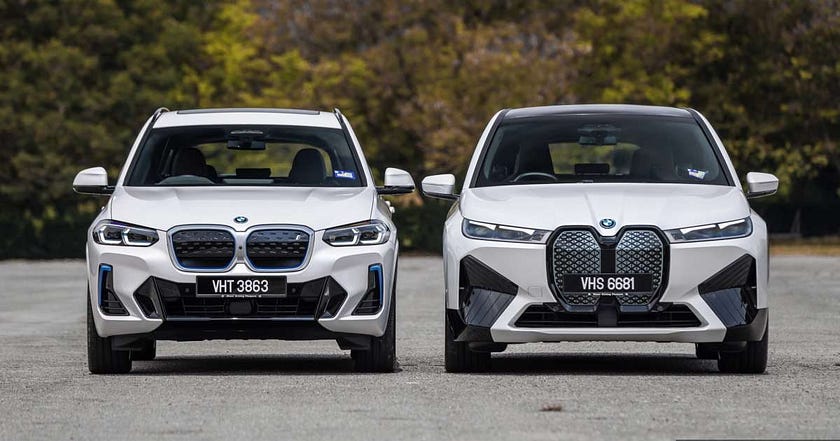BMW iX vs BMW iX1 Comparison: Choosing the Ideal BMW Electric Car for Indian Roads

As the automotive world shifts toward electric vehicles (EVs), BMW has introduced two standout models: the iX1 and the iX. These vehicles represent the brand’s commitment to innovation, design, and sustainability. In this blog, we’ll explore the unique features, performance capabilities, and design elements of both models to help prospective buyers make an informed choice.
Design: The Aesthetic Appeal
BMW iX1
The BMW iX1 is a recent addition to BMW’s EV lineup, boasting a design that is both modern and familiar. It closely resembles the traditional X1 U11, its internal combustion engine (ICE) counterpart, making it an attractive option for those transitioning from conventional BMW models. The iX1 is distinguished by subtle blue accents on the exterior and interior, along with advanced digital features in the cabin. Despite sharing a platform with the ICE X1, the iX1 has a slightly lower stance, giving it a sporty look that enhances its visual appeal.
BMW iX
The BMW iX, particularly the M60 variant, stands out with its bold and distinctive design. Its vertically oriented grille, often described as “toothy,” sets it apart from other SUVs on the market. This design choice has sparked both admiration and debate, making the iX a conversation starter among EV enthusiasts.
Practicality: Space and Comfort
BMW iX1
The iX1 offers impressive interior space, nearly matching the roominess of the larger X3. The large doors allow for easy entry and exit, while the comfortable front seats ensure a pleasant ride even on long journeys. The rear seats feature a 40/20/40-split configuration and offer slight recline, although they lack the sliding function available in the ICE X1. The iX1 does sacrifice some cargo space to accommodate the rear-axle-mounted electric motor and battery pack, resulting in a cargo volume of 490 to 1495 liters, which is slightly less than the ICE X1.
BMW iX
The BMW iX M60 is a true powerhouse in terms of space. With nearly five meters in length and a three-meter-long wheelbase, the iX offers an expansive interior that comfortably accommodates a family. The SUV’s significant dimensions make it a commanding presence on the road while providing ample room for passengers and cargo.
Price and Features: Value for Money
BMW iX1
The iX1 is available in a single trim, the xDrive30, with a starting price of approximately ₹60 lakhs. Buyers have the option to choose between the sportier ‘M Sport’ package and the more traditional ‘xLine’ package at no additional cost. Standard features include a twin-motor all-wheel drive system, a 67 kWh battery, 22 kW AC charging, and adaptive dampers. Although the iX1 lacks Vehicle-to-Load (V2L) capability, it offers various customization options, including the 22 kW BMW AC Wallbox for faster home charging.
BMW iX
The iX series offers four variants, with the M60 at the top, priced at ₹1.15 crores (Ex-showroom). This variant represents the peak of BMW’s EV performance and features, catering to those seeking a premium electric SUV experience.
Power and Performance: The Driving Experience
BMW iX1
The iX1 is powered by BMW’s fifth-generation EV drive system, featuring two electric motors for all-wheel drive. The combined output of 230 kW and 494 Nm of torque enables the iX1 to accelerate from 0 to 100 km/h in just 5.6 seconds, with a top speed of 180 km/h. The vehicle’s suspension system, which includes MacPherson-style struts at the front and an independent three-link design at the rear, contributes to a smooth and responsive driving experience.
BMW iX
The iX M60 offers a formidable powertrain with two electric motors that generate an impressive 455 kW of power and 1100 Nm of torque. This allows the SUV to accelerate from 0 to 100 km/h in a mere 3.8 seconds, despite its 2.5-tonne weight. The iX M60’s performance surpasses many traditional petrol-powered competitors, making it a standout in the EV market.
Efficiency and Range: Long-Lasting Power
BMW iX1
BMW estimates that the iX1 consumes about 18.3 kWh/100 km on average, with real-world usage showing slightly higher consumption at 21.3 kWh/100 km. The iX1’s 67 kWh battery provides an ADR 81/02-rated range of 400 km. Charging options include a 50 kW DC public charger, which takes about 65 minutes to charge from 10% to 80%, and a 150 kW charger that cuts this time to around 30 minutes. Home charging is also feasible, with the 22 kW AC Wallbox reducing the full charge time to approximately 3.5 hours.
BMW iX
The iX M60 is officially rated at 26.5 kWh/100 km, but real-world usage has shown a slightly better average of 25.6 kWh/100 km. This efficiency surpasses some other high-performance electric vehicles, making the iX M60 a compelling option for those seeking both power and efficiency.
Safety: A Secure Ride
While specific safety ratings for the iX1 are not yet available, the iX1 variants have earned a five-star ANCAP rating based on the European NCAP result in 2022. The iX1 comes with a comprehensive suite of driver-assist safety technologies, including Automatic Emergency Braking (AEB) with pedestrian and cyclist detection, lane support systems, and a driver monitoring system. Occupant protection is enhanced with seven airbags and ISOFIX child-seat latches.
In contrast, the iX is notably missing rear AEB, a surprising omission given its otherwise extensive safety features.
Conclusion
Both the BMW iX1 and iX offer exceptional electric driving experiences, each catering to different needs and preferences. The iX1 is a practical, sporty option with a lower price point, making it ideal for those seeking a balance between performance and cost. On the other hand, the iX M60 stands as a luxury powerhouse, offering top-tier performance, space, and features. Whether you prioritize innovation, design, or sustainability, BMW’s electric lineup has something to offer in 2024.


Comments
Post a Comment